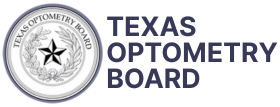All applicants must have taken the following NBEO exams:
- Parts I and II of the NBEO on or after January 1, 1984,
- Part III of the NBEO on or after June, 1994, and
- TMOD on or after January 1985
However, Board rules do allow for NBEO Part III to be exempted via a different application process. An applicant must have taken Part I, Part II, and the TMOD. If the applicant has not passed Part I, Part II, or the TMOD the application will be rejected.
To be eligible and qualify for a therapeutic optometric license under Board Rule 271.5, an applicant who has not taken Part III of the National Board of Examiners in Optometry must:
- currently be licensed as a therapeutic optometrist in good standing in another state, the District of Columbia, or territory of the United States;
- have passed an examination that is equivalent or superior to the examination required in Texas at the time of licensure;
- have, for at least five of the seven years preceding the application date, been actively engaged in the practice of therapeutic optometry; or engaged in full-time teaching at an accredited college of optometry or medicine;
- have no pending disciplinary actions in the state, district, or territory in which the applicant is licensed;
- have never had an optometric license suspended or revoked.
Application Deadline – All License Without Exam applications must be approved by the Board at a regularly scheduled Board Meeting. The completed application with all supporting documents must be in the Board’s office at least 30 days prior to the Board Meeting (Board Meeting Calendar).
Application – Apply here. If using the online application, choose “LWOE Acceptance Application” under Step 3.
A completed application consists of:
- application (answering all questions) and $305 fee
- license verifications from each state of license (see license verifications below);
- official transcript(s) received directly from optometry school showing awarding of O.D. degree
- transcripts from all colleges attended (copy acceptable)
- proof of residency (copy of US birth certificate, Real ID drivers license, Permanent Resident Card, Employment Authorization card)
- passing scores on NBEO Parts I, II and the TMOD (provide OE Tracking number on application and allow Board access on NBEO site)
- passing score on the Texas Jurisprudence Exam (taken via NBEO site)
- self-query ordered from the National Practitioner’s Databank (NPDB)
- proof of successful completion of a CPR or BLS certification that is not-expired
- proof of successful completion of two-hour continuing education course related to prescribing and monitoring controlled substances as required by Section 481.07635 of the Health and Safety Code
- criminal background check* (See Fingerprint Information)
- Copy of document changing name (if applicable)
- Military discharge (if applicable)
*Fingerprints may be submitted after the application is reviewed by the Board, but must be submitted before a license can be issued.
License Verification
The state(s) you are licensed (or were previously licensed) in must provide information to the Board regarding your initial license and therapeutic license, so that the Texas Optometry Board can determine whether that licensing process was equivalent or superior to the Texas licensing process at that time (see eligibility requirements, above). Applicants should send the Texas verification form to the licensing board in each state of license and request that the form be filled out completely (there may be a fee charged). The state will send the completed form to the Texas Optometry Board.
License Issued
Applicants will be issued a license to practice therapeutic optometry after:
- approval of application by Board,
- passing of the Jurisprudence Exam, and
- payment of initial licensing fee.
Optometric Glaucoma Specialist: Once licensed as a Texas therapeutic optometrist, doctors may complete the requirements for an optometric glaucoma specialist license.
